¶ Pest & Disease Models
¶ Apples
¶ Apple Ascospore
Apple scab is caused by the fungal pathogen, Venturia inaequalis. The fungus overwinters on dead leaves and fruit on the ground. In the spring, the fungus forms small black sexual fruiting bodies (pseudothecia) on fallen infected plant materials and releases sexual spores (ascospores) during periods of wet, rainy weather. Ascospores are dispersed by wind and rain-splash onto newly emerging leaves and fruit and initiate infection. After the primary infection has occurred, abundant conidia (asexual spores) are formed in these lesions and are dispersed to other leaves to start the secondary infection. The secondary infection cycle repeats many times during the growing season and is associated with wet weather conditions and the levels of host resistance.
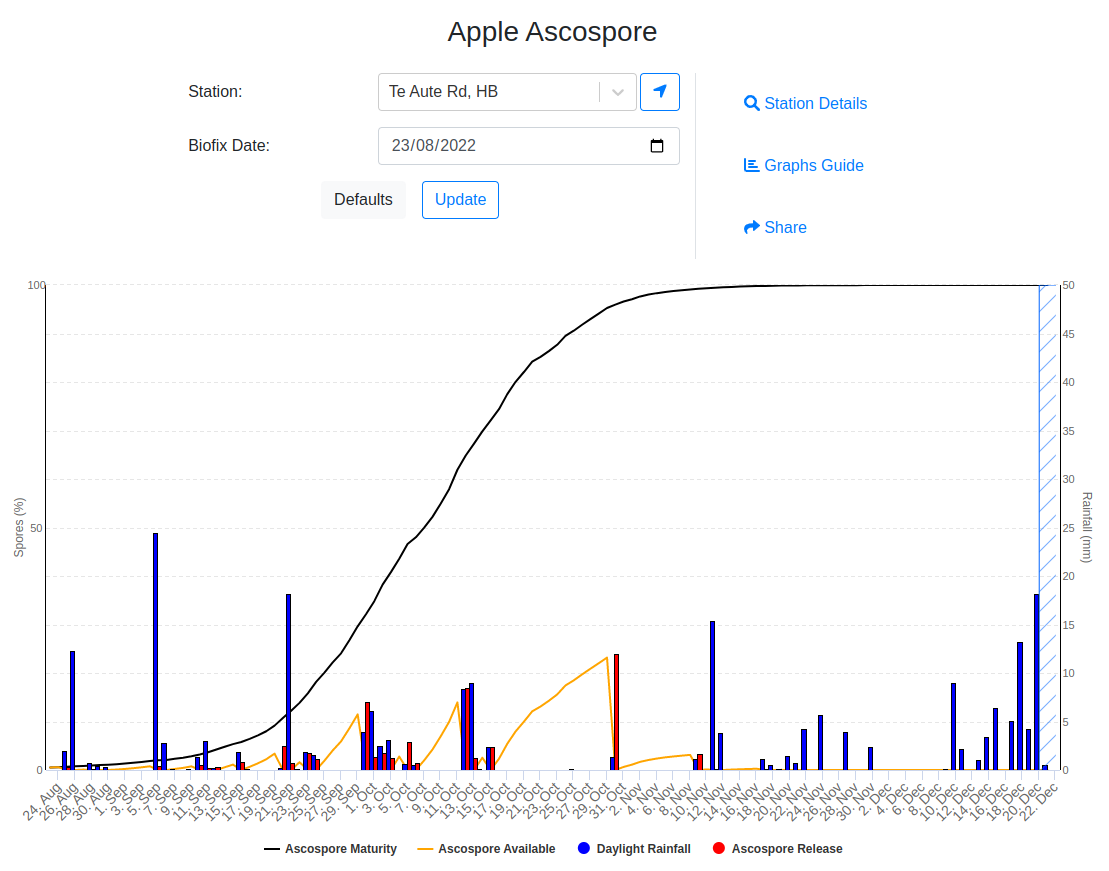
¶ Apple Fireblight
Fire blight is a common and very destructive bacterial disease of apples and pears. The disease is caused by the bacterium Erwinia amylovora, which can infect and cause severe damage to many plants in the rose (Rosaceae) family. On apples and pears, the disease can kill blossoms, fruit, shoots, twigs, branches and entire trees.
Fire blight first appears in the spring when temperatures get above 18.3°C. Rain, heavy dews and high humidity favor infection. Precise environmental conditions are needed for infection to occur and as a result disease incidence varies considerably from year to year.
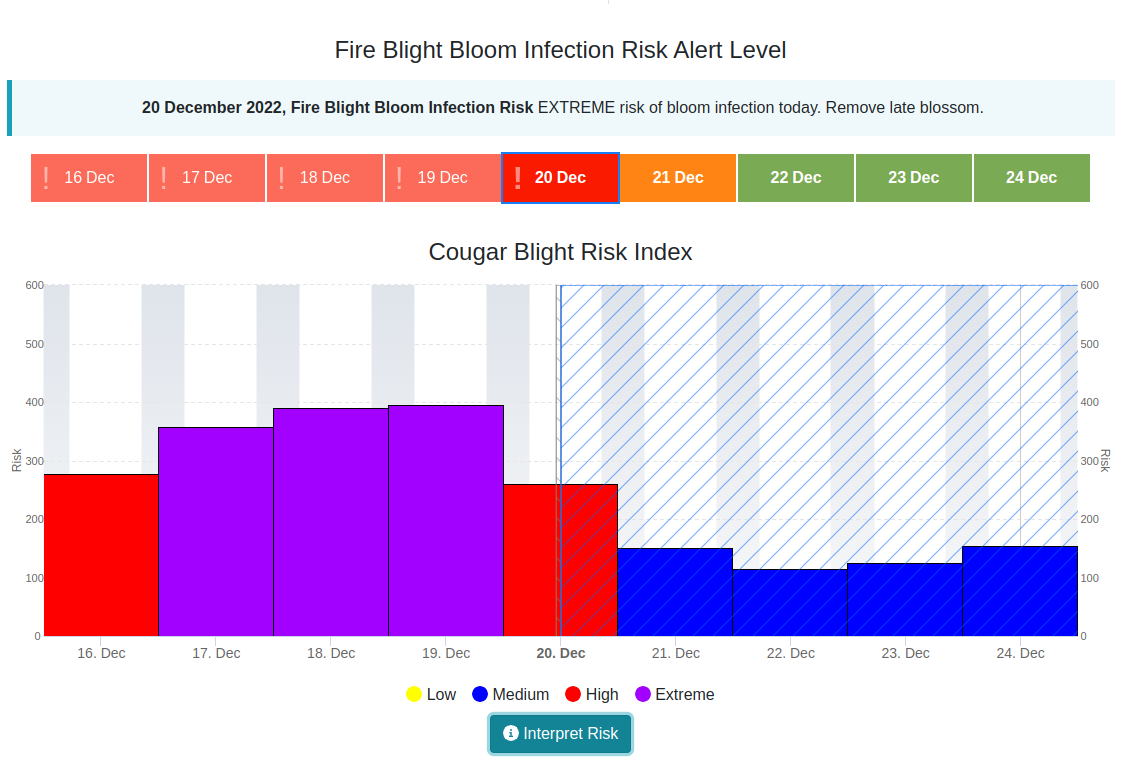
¶ Apple Black Spot
Apple scab or black spot is caused by the fungus Venturia inaequalis (Cooke) Wint. This disease can infect the aerial parts of apple trees including leaves, petioles, flowers, fruits, pedicels, young shoots and bud scales. It is favoured by cool, rainy and humid spring and summer conditions.
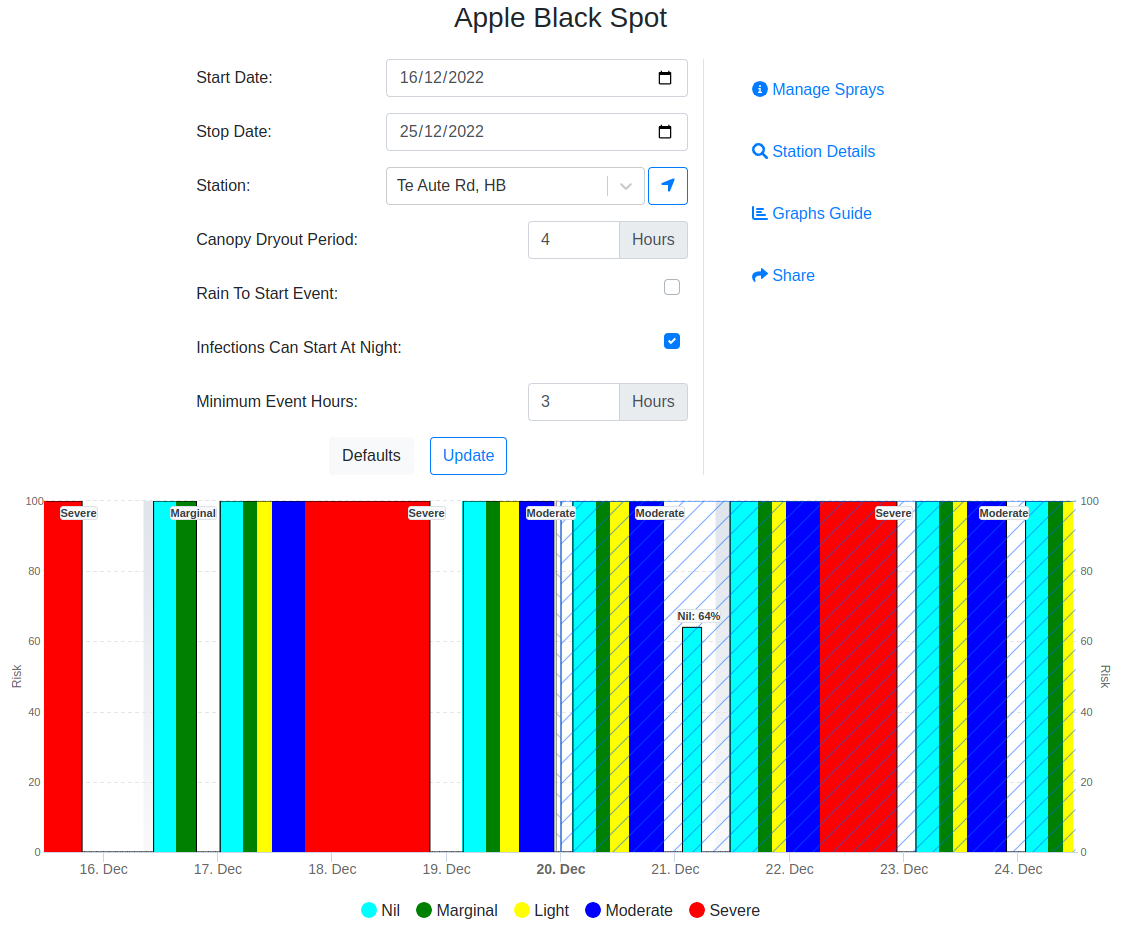
¶ Codling Moth
The codling moth (Cydia pomonella) is a major pests to agricultural crops, mainly fruits such as apples and pears. Because the larvae are not able to feed on leaves, they are highly dependent on fruits as a food source and thus have a significant impact on crops.
Codling moth development is modelled using GDD Accumulation and a fixed biofix date depending on your orchard location. Spraying for codling moth must be undertaken in the green zone (80 - 100 GDDs) and should finish by the yellow zone. During the red zone moth larvae will enter the fruit and will not be affected by sprays.
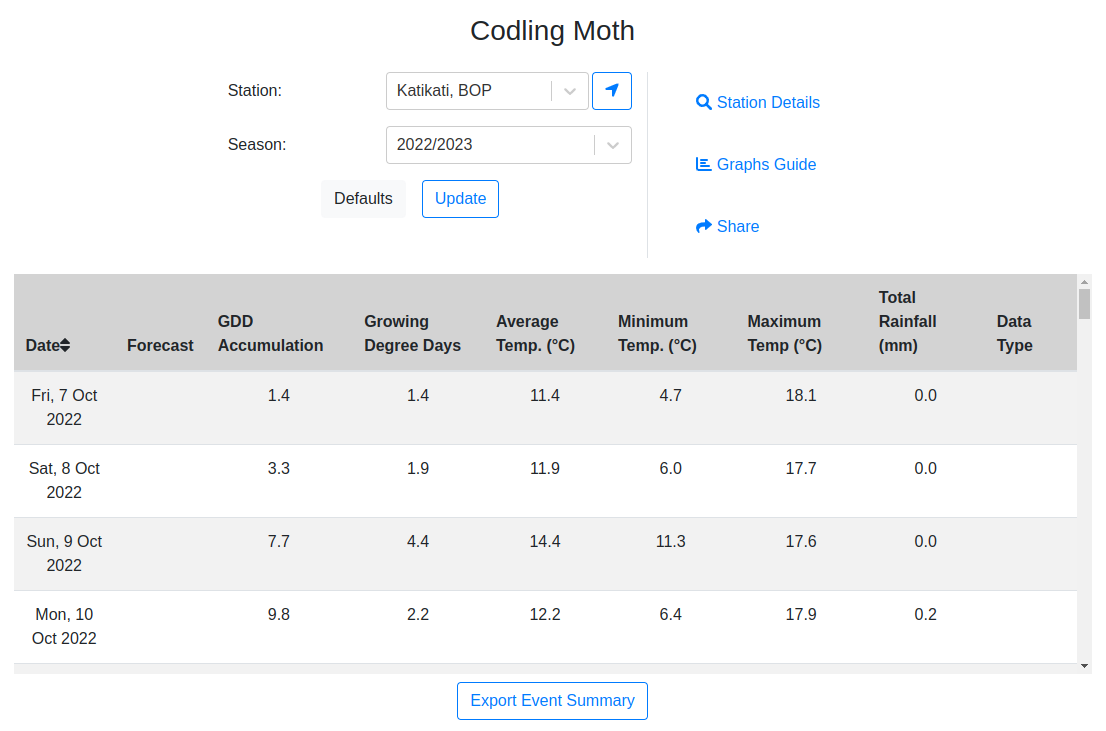
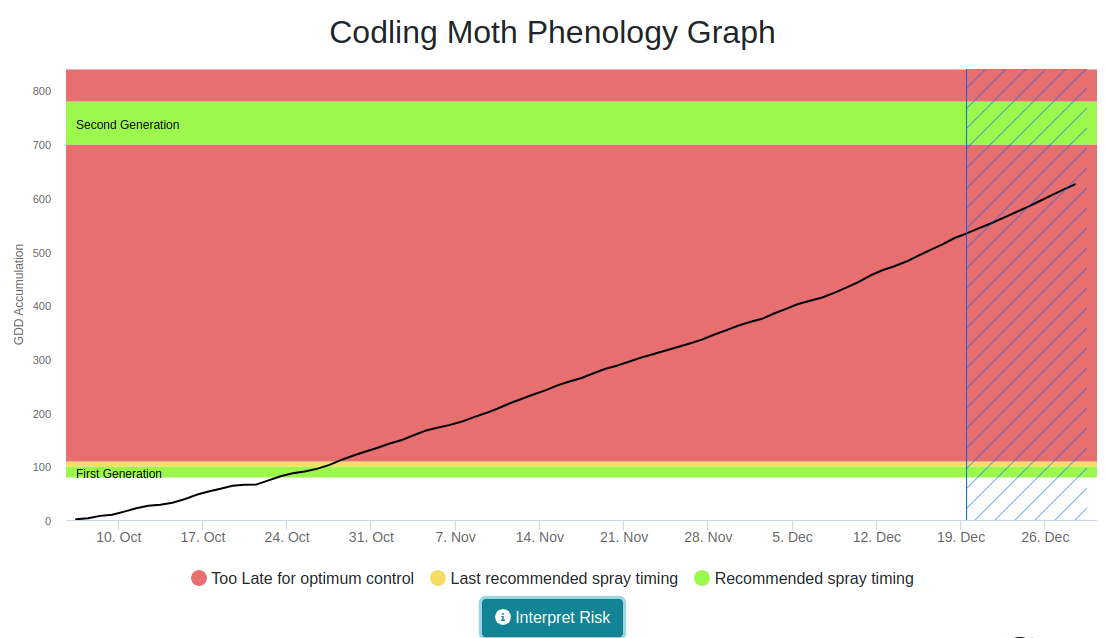
¶ Stonefruit
¶ Brown Rot Risk
Brown rot can cause serious losses to stone fruit, especially in seasons with very wet weather during flowering or immediately pre-harvest. Losses are mainly associated with blossom blight (which reduces fruit set and potential yield), and brown rot on maturing fruit close to harvest. Significant losses can also occur to fruit after harvest.

¶ Leaf Curl Risk
Peach leaf curl, also known as leaf curl, is a disease caused by the fungus Taphrina deformans. Peach leaf curl affects the blossoms, fruit, leaves, and shoots of peaches, ornamental flowering peaches, and nectarines, and is one of the most common disease problems for backyard gardeners growing these trees. The distorted, reddened foliage that it causes is easily seen in spring. When severe, the disease can reduce fruit production substantially.
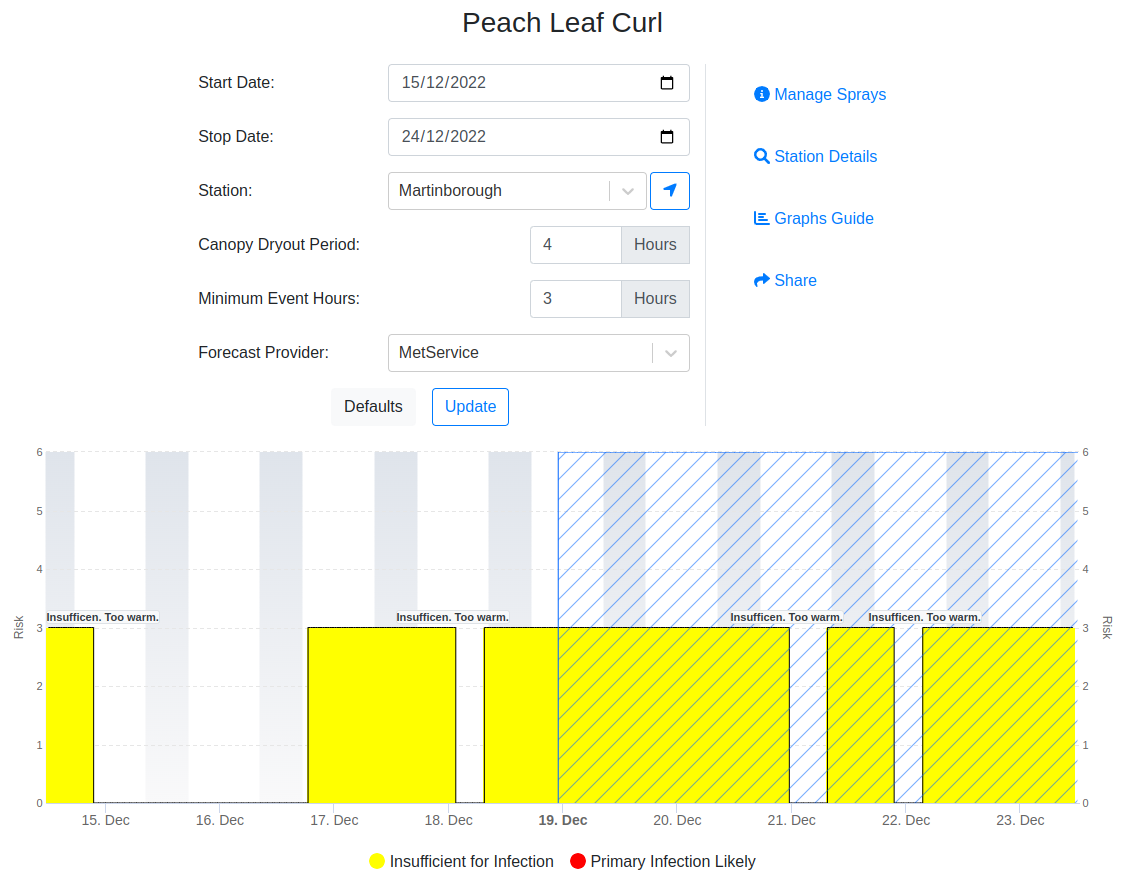
¶ Leaf Rust Risk
Stone Fruit Rust is caused by the pathogen species Tranzschelia and is indicated by brown rust spores on the undersides of leaves. A relatively serious disease in stone fruits and can cause severe defoliation in summer and weakens the trees. Early autumn defoliation can result in off-season bloom during autumn and winter, which reduces yield the following spring.
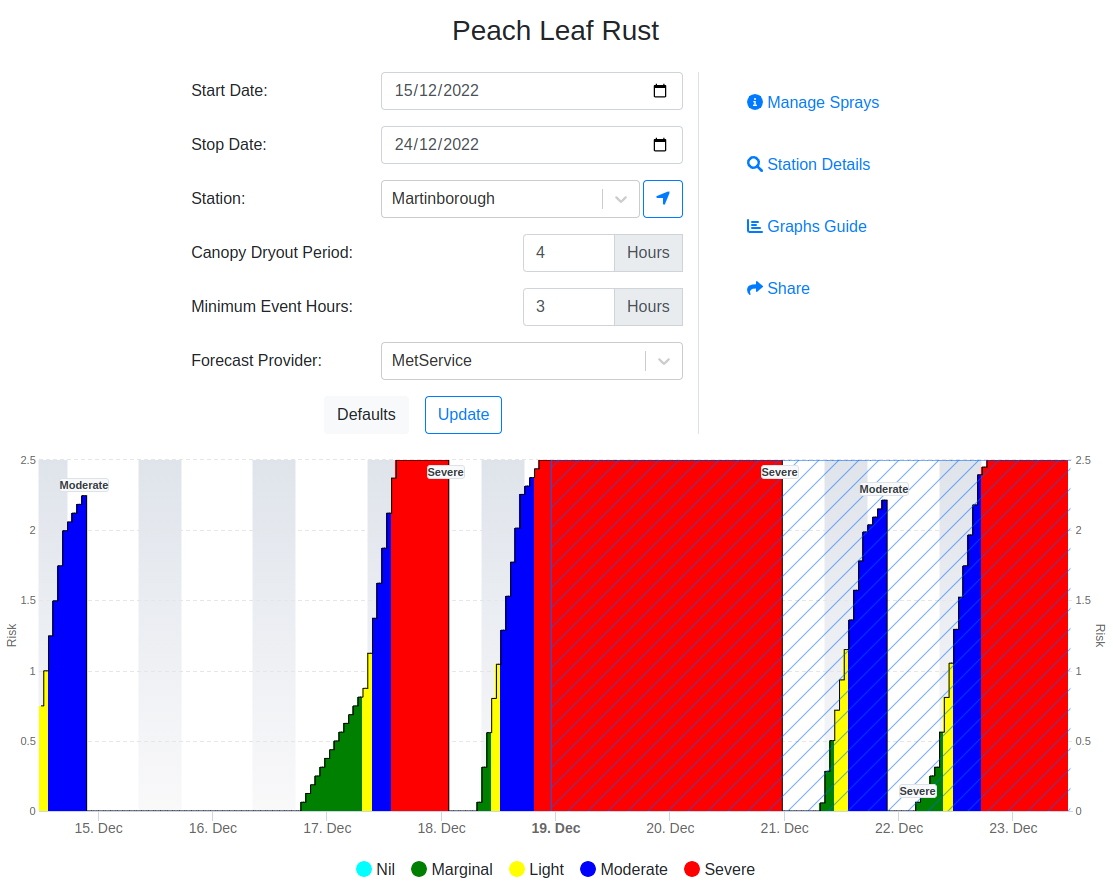
¶ Potato
¶ Potato Tuber Moth
The potato tuber moth is a major pest of potatoes, and can also attack other crops of the Solanaceae family. As with all lepidopteran pests, the larval stages (caterpillars) are those that carry out the damag. They mine in leaves and stems, and in case of potatoes also in the tubers where they can further survive and multiply during storage. This is a big problem when the tubers are used as seeds, because the pest moves to re-infest or infest a field where there was no presence of the moth.
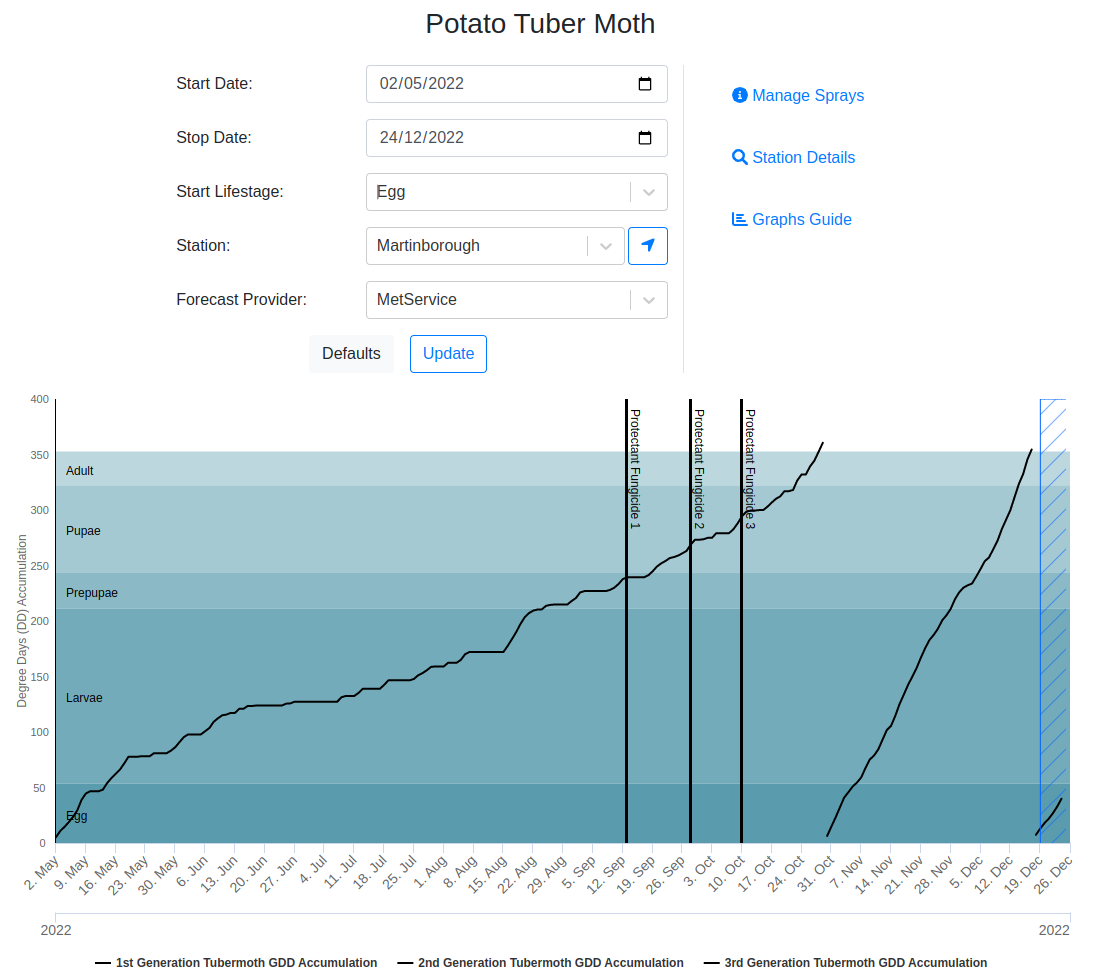
¶ Tomato/Potato Psyllid
Tomato/potato pysllid is a sap-sucking insect that feeds mainly on members of the Solanaceae family including tomato, potato, capsicum, chilli and eggplant. It goes through three stages of development: 1) egg, 2) nymph, 3) adult. Tomato/potato psyllid breeds all year, especially in the warmer parts of the country and in greenhouses.
The number of eggs laid also depends upon the host plant. The rate of development of nymphs is dependent on temperature. The psyllid develops between 15°C and 32°C with optimum development at 27°C. In a greenhouse with an average temperature of 18°C psyllids takes 33 days to complete their life cycle.
On tomatoes, psyllids can cause numerous poor quality fruit to form, or fruit can be prevented from forming. On potatoes psyllid feeding can cause a reduction of yields, poor quality tubers, and/or reduce the number of secondary tubers forming. The quality of the tubers can also be affected, once cut or fried tubers can show Zebra chip symptoms, and tubers will often taste unpleasantly earthy.

¶ Kiwifruit
¶ Psa
The highly virulent bacterium Pseudomonas syringae pv. actinidiae (Psa) causes bacterial canker on kiwifruit vines. Psa is believed to be spread by weather events, namely wind and rain, and plant material. It is also believed to be spread by footwear, vehicles and orchard tools.
The Kiwifruit Psa-V Risk Model shows the current and forecast daily environmental risk assessment of Psa-V infection conditions. Weather station and forecast data are updated throughout the day so the most recent information is always available. Some weather stations have records for many years. You can browse the results for any of these periods by specifying a start and stop date, selecting a weather station then clicking the 'Update' button to apply the new options.

¶ Onion
¶ Onion Stemphylium
Stemphylium leaf blight is a foliar disease of onions worldwide caused by the fungus Pleospora allii. It survives on infected plant debris and resumes growth during favorable weather conditions in spring. It then produces spores that are spread to nearby plants by the wind. Long periods of warm wet conditions encourage disease development.
The Stemphylium Leaf Blight model interprets weather conditions for the general likelihood of infection based on research and expert knowledge, helping identify the optimal timing for growers to achieve good control.
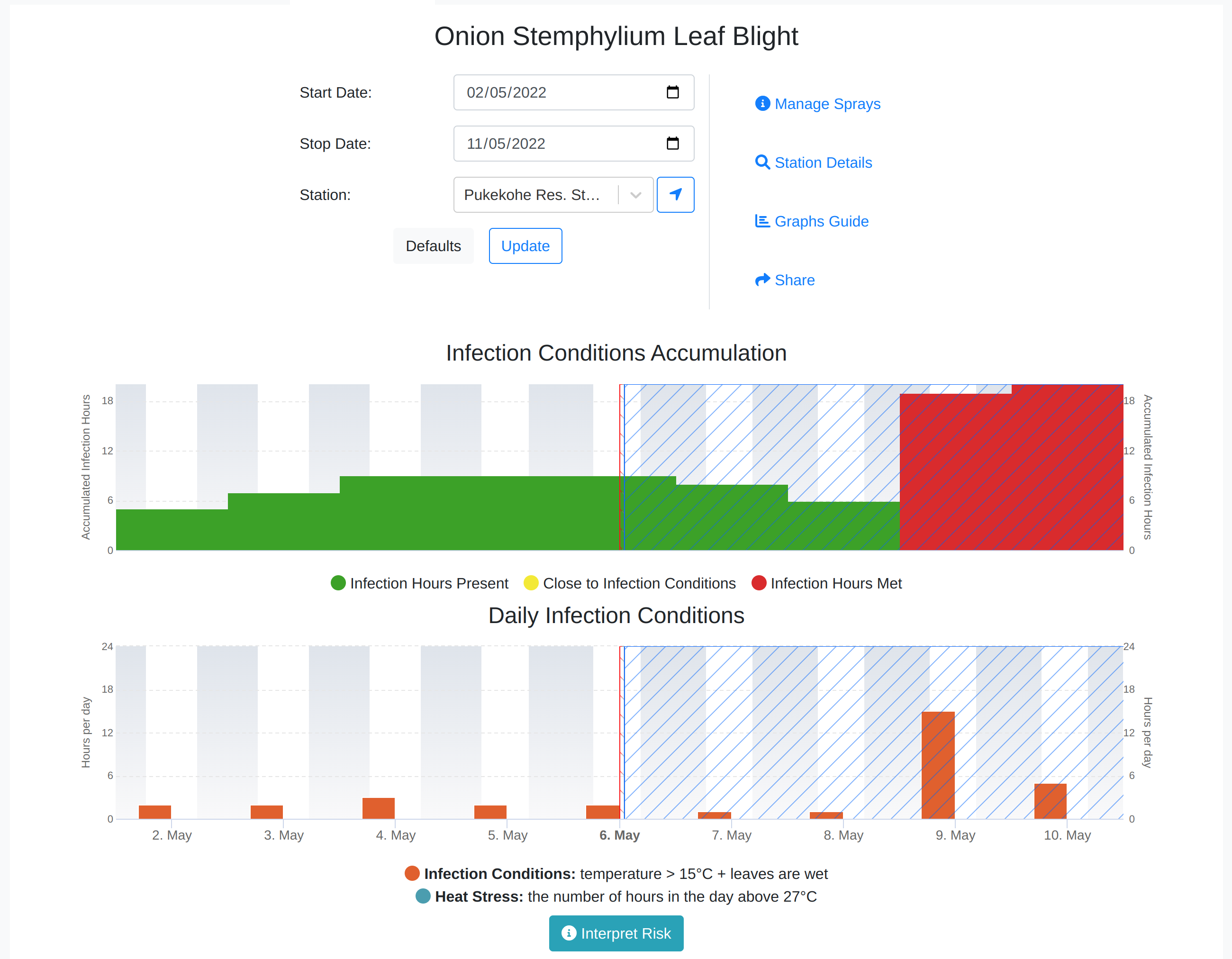
¶ Onion Downy Mildew
Downy mildew is caused by the pathogen Peronospora destructor and can defoliate the onions and related crops prematurely. The fungus spores spread and cause infection, especially in cool, humid, and moist conditions.
The Onion Downy Mildew Disease model makes it easier to identify when there are infection and germination conditions. The model includes a Leaf Wetness parameter, which plays a critical role in disease risk management. Using this model, growers can now more quickly and clearly understand the risk level in their paddock.

¶ Onion White Rot
Onion white rot is caused by a fungus (Sclerotinia cepivorum) that destroys the roots, killing the plant. It then produces resting bodies that can last for many years in the soil.
This model first predicts seed germination (the disease trigger) from the planting date provided. Then predicts the time for the disease symptoms to appear in the field - 250 wrdd (white rot degree days).

¶ Plant
¶ Myrtle Rust
Myrtle rust (Puccinia psidii) is a wind-borne fungal disease which infects plants such as pōhutukawa, mānuka, rātā, kānuka, swamp maire, ramarama and eucalyptus.
The Myrtle Rust model was developed by funding from the MBIE Ngā Rākau Taketake – Myrtle Rust and Kauri Dieback Research programme. Data used to inform the model were obtained from the MBIE Beyond Myrtle Rust programme and from myrtle rust research funded by Biosecurity New Zealand (MPI).
Learn more about the Myrtle Rust and model here! - https://myrtlerust.com/.
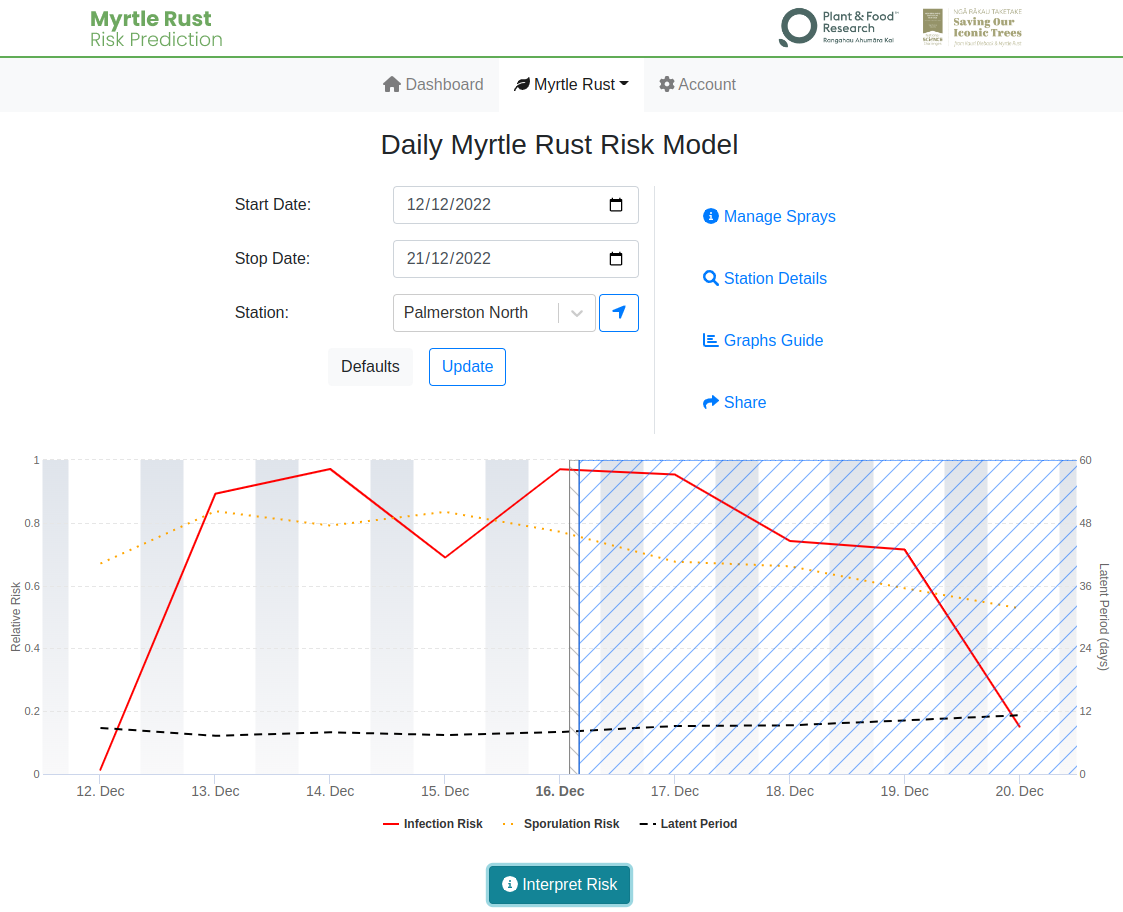
¶ Grape
¶ Botrytis rot
Botrytis rot, caused by the fungus Botrytis cinerea, is a common problem wherever grapes are grown. The disease can cause serious losses in both yield and quality when weather conditions favour the disease. The fungus Botrytis cinerea attacks grapes (and occasionally other parts of the vine) in humid conditions.

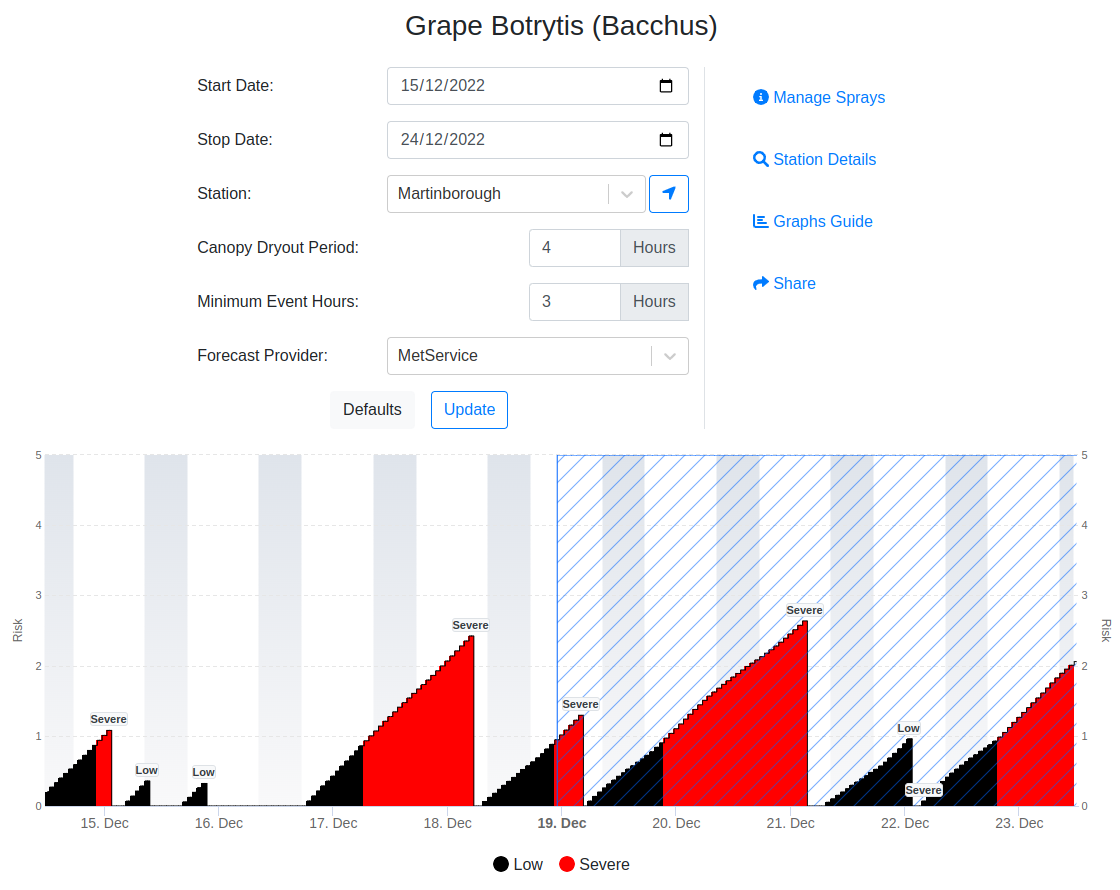
¶ Grape Downy Mildew
Downy mildew is a major disease of grapevines caused by the fungus Plasmopara viticola. The fungus is spread by wind and water and favourable conditions for infection and disease development occur in warm wet weather, especially in late spring and early summer.
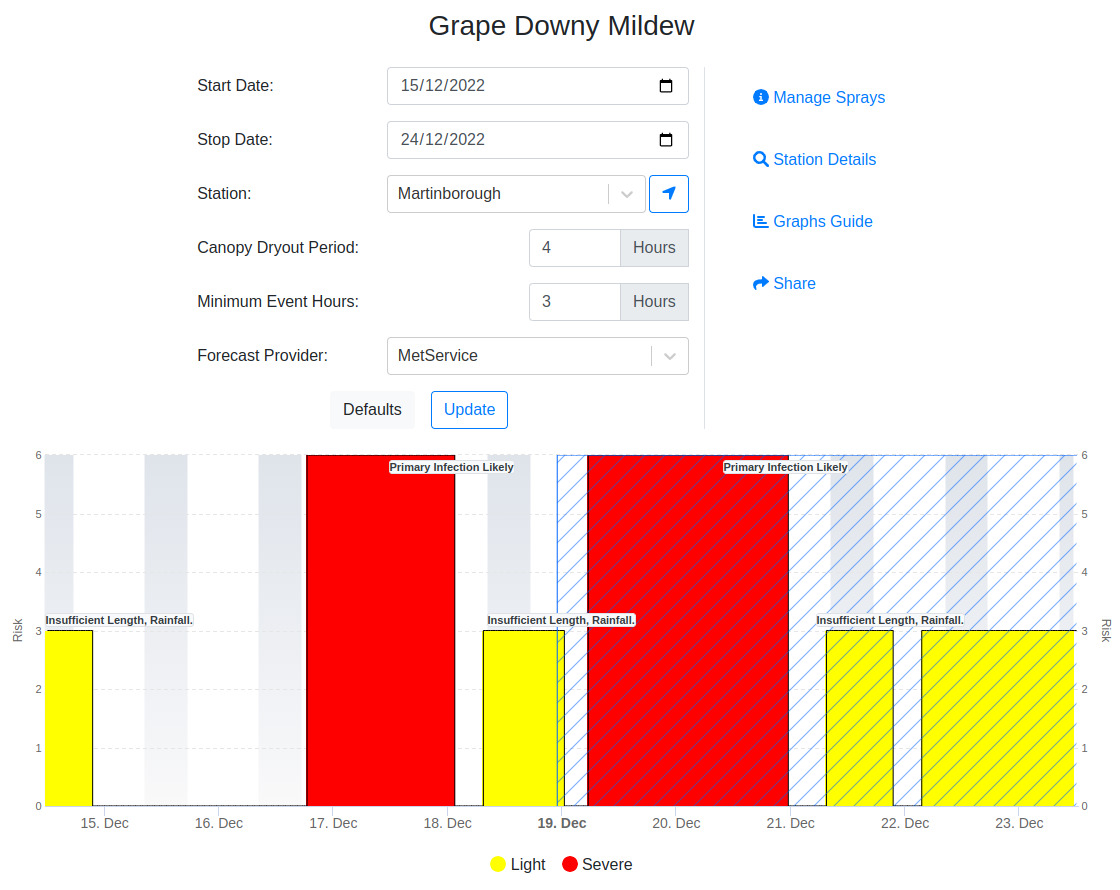
¶ Grape Powdery Mildew (Gubler)
Powdery mildew, caused by the obligate biotrophic fungus Erysiphe necator, is an economically important disease of grapevines worldwide. Large quantities of fungicides are used for its control, accelerating the incidence of fungicide-resistance. The model uses weather conditions to track the primary infection and let growers know when to start treatment in the beginning of the season.
